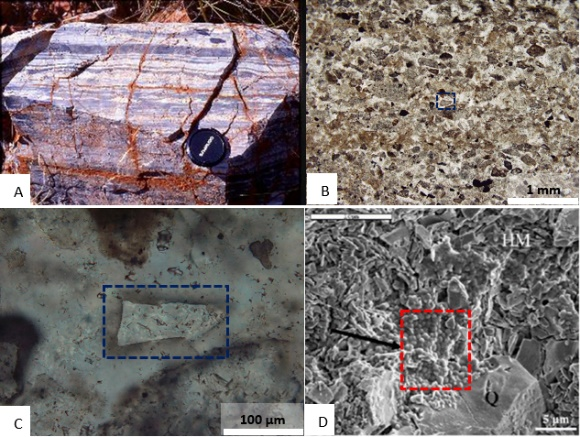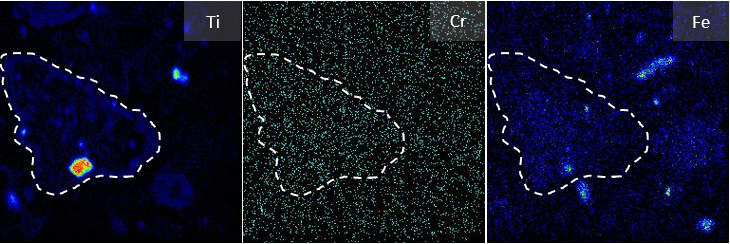Identifying biosignatures in a Mars-analogue volcanic rock: The ~3.5 Ga Kitty’s Gap chert
- 1CNRS, Centre de Biophysique Moléculaire, Orléans, France (laura.clodore@cnrs-orleans.fr)
- 2Natural History Museum, London, UK
- 3CNRS, University of Bordeaux, IN2P3, CENBG, Gradignan, France
Did life ever exist on Mars? This is the question that present and future missions to Mars (MSL, Mars 2020, MSR, and ExoMars) are trying to answer.
Although the present conditions on Mars make the presence of extant life highly unlikely at the surface, life may have appeared early in its history, during the Pre-Noachian and Noachian periods, when surface conditions permitted habitability and, potentially, the development of the first forms of cellular life (Cockell et al., 2014; Westall et al., 2015). However, given the conditions of punctuated habitability, if life ever appeared, it most likely remained at a relatively primitive stage of evolution (chemotroph-like organisms, although anoxygenic photosynthetisers cannot be completely ruled out) and the associated remains would be comparable to the very small and subtle chemotrophic microfossils observed in the early terrestrial record (Westall et al., 2015). In order to improve their detection in martian rocks, we therefore study fossil traces of life associated with ancient, 3.45 Ga, terrestrial volcanic sediments whose biological signatures are possible analogues of the signatures of life that could be found on Mars.
The 3.446 Kitty’s Gap chert:
The 3.45 Ga Kitty’s Gap chert (Pilbara, Australia) is a typical example of silicified volcanic sediments deposited in a shallow, littoral water environment, and in the vicinity of a hydrothermal vent linked to a volcanic system, an excellent analogue for the Noachian environments on Mars (Fig. 1A; Westall et al., 2006, 2011).
The Kitty’s Gap sediments hosted microorganisms interpreted as anaerobic, autotrophic chemolithotrophs that colonized the surface of volcanic particles, as well as the dusty matrix (Fig. 1B-C). These kinds of microbes were common on the early Earth, living in anaerobic, volcanic environmental conditions similar to those on early Mars (Westall et al., 2015). The microorganisms occur as silicified, small (< 1 µm) coccoidal structures forming very small and dispersed colonies (Fig. 1D). Moreover, the total sediment is low in organic carbon (0.01–0.05 wt. %). Therefore, the carbonaceous remains of these microorganisms are very subtle and difficult to identify, and their analyses required a multi-technique approach to demonstrate their biogenicity.

Fig. 1. (A) Outcrop of the volcanic sediments in the Kitty’s Gap chert. Scale-lens cap 5.4 cm. (B) Optical image of the volcanic particles in the rock. (C) Volcanic particle (outlined in B) surrounded by organic matter (brown). (D) SEM micrograph showing colonies of chemolithotrophs in volcanic sediments (Westall et al., 2006).
Microfossils study:
The identification of fossil microorganisms is based on a number of criteria (see Westall et al., 2006) including:
- compatibility of the depositional environments with the existence of living organisms, such as physico-chemical conditions, availability of energy, carbon and nutrients sources;
- demonstration of characteristics indicative of biogenicity, i.e. morphological and biogeochemical characteristics;
- interactions between living organisms and their immediate environment, such as microbial alteration and colonization of the substratum, formation of mats/biofilms, stabilization of the sediments via fossilization processes;
- lack of abiogenic alternatives.
In addition to proving biogenicity, it is also necessary to prove syngenicity.
Multi-technique study to evaluate environmental conditions…
The habitability of the Kitty’s Gap chert is investigated by multiple complementary instruments in order to characterize the paleoenvironment conditions of the rocks. Macroscopic and microscopic observations (optical microscopy and SEM), Raman spectroscopy, ICP-MS and LA-ICP-MS provide information about the origin and formation of rocks, but also on the alteration processes that contributed to their mineralogical, morphological and chemical transformation, as well as their preservation (Fig. 2).
Fig. 2. MuQ-normalised bulk ICP-MS measurements of REE + Y in the two studied units, 00AU39 and 00AU40. The REE + Y profiles indicate a deposit in a semi-enclosed basin, influenced by seawater, terrigenous, and hydrothermal inputs.
…and determine biogenicity
The characterization of primitive fossils microbes requires the identification of morphological, elemental and molecular biosignatures. For this purpose, the carbonaceous matter around the volcanic particles (Fig. 1C) is studied using different observation and analytical techniques such as optical and electronic microscopy, Raman spectroscopy, UV and visible fluorescence spectroscopies, EDX, ToF-SIMS, and FTIR. Trace metal elements associated with metabolisms as well as trapped by the extracellular polymeric substances (EPS) prior to silicification may be also identified using techniques such as Particle-Induced X-ray Emission, X-ray micro-fluorescence, and LA-ICP-MS (Fig. 3).

Fig. 3. µ-PIXE elemental mapping of a volcanic particle in the Kitty’s Gap chert. The volcanic particle is surrounded by organic matter enriched in transition metal elements, including some biofunctional elements, such as Ti, Cr, Fe, Co, Ni and Cu.
Conclusion: Formed in situ in coastal volcanic sediments, the organic coatings on volcanic detrital grains and small colonies of interpreted coccoidal chemolithotrophic organisms in the Kitty’s Gap chert are representative of possible martian biosignatures, especially some of which could be decisive for the detection of potential traces of life on Mars.
Summary: Investigation of the habitability of the paleoenvironment of the oldest cellular forms of life found on Earth, and documentation of primitive life signatures and the methods used to characterize them, will be relevant for selecting samples in situ for analyses and/or sample return from Mars, as well for identifying biological signatures in returned martian materials.
References:
Cockell, C.S. (2014) Trajectories of martian habitability. Astrobiology 14:182–203.
Westall, F. et al. (2006) The 3.466 Ga “Kitty’s Gap Chert”, an early Archean microbial ecosystem. Geological Society of America 405:105–131.
Westall, F. et al. (2011) Volcaniclastic habitats for early life on Earth and Mars: A case study from ~3.5 Ga-old rocks from the Pilbara, Australia. Planetary and Space Science 59:1093–1106.
Westall, F. et al. (2015) Biosignatures on Mars: What, Where, and How? Implications for the Search for Martian Life. Astrobiology 15:998–1029.
How to cite: Clodoré, L., Foucher, F., Hickman-Lewis, K., Sorieul, S., Réfrégiers, M., Collet, G., and Westall, F.: Identifying biosignatures in a Mars-analogue volcanic rock: The ~3.5 Ga Kitty’s Gap chert, Europlanet Science Congress 2022, Granada, Spain, 18–23 Sep 2022, EPSC2022-15, https://doi.org/10.5194/epsc2022-15, 2022.

